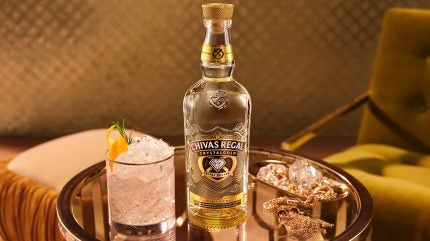
Innovation in the drinks industry might just be the original double-edged sword. You need to deploy it if you want growth but the vast majority of wholly new products are doomed to fail and fail in short order. You can play it safe with line extensions and limited editions – but, if you really want to transform the fortunes of a brand, recruit new consumers and/or target fresh occasions, you need to try something rather more radical.
This is the context that underpins the launch of Chivas Regal Crystalgold, the clear spirit drink that emphatically isn’t whisky, except that it kind of wants to be. It’s a blend, rendered entirely clear by some jiggerypokery involving temperature conditions, flow rates and bespoke filtration systems – and teaspooned with a tiny amount of new make spirit, reportedly at the insistence of the Scotch Whisky Association (SWA), who wanted it made crystal-clear (sorry) that this isn’t Scotch.
It’s a tricky area and one that’s reminiscent of the old debate around so-called ‘flavoured whisky’ (remember that?). The label for Chivas stablemate Ballantine’s Brasil – Scotch mingled with lime flavouring – may say ‘spirit drink’ but the brand banner still screams Scotch. Ditto here. Cue furrowed brows in the SWA offices.
A few questions present themselves. First: why Chivas? Among the Chivas Brothers Scotch brands, populist Ballantine’s would seem a more obvious candidate for such a clear departure from Scotch norms – Chivas has historically been the company’s luxury blend, with a more traditional image.
But perhaps that’s precisely the point. For all its upmarket reputation, Chivas has begun to look a little dusty in recent years. By deliberately making this a relatively high-end product – it has a UK retail price of £51 ($68), similar to that of Chivas XV, a conventional 15-year-old blend – the aim is clearly to take Chivas into new territory without tarnishing its premium image.
My initial reaction when I saw the press release headlines about Crystalgold was to cast my mind back nearly 20 years to Diageo’s launch of J&B -6oC, another white non-whisky, taking its name from the temperature of the chill filtration used to strip the colour from the spirit.

US Tariffs are shifting - will you react or anticipate?
Don’t let policy changes catch you off guard. Stay proactive with real-time data and expert analysis.
By GlobalDataThat ill-starred venture – it was hooked from the market within 12 months – was a desperate move to chase the vodka trend as J&B’s sales fell off the proverbial cliff in Spain. Everything about it – from concept to product quality – was a terrible misjudgement.
Simultaneously chasing the cristalino and aperitivo/spritz trends feels a little muddled to me
I’m not sure that Crystalgold will meet a happier fate but this is emphatically not an effort to shoehorn Chivas into the vodka category. The clue’s in the name. Crystalgold – to me, at least – immediately evokes cristalino, the hugely successful agave offshoot that produces a clear but characterful spirit through filtration of aged or añejo Tequila. And what’s one of Crystalgold’s signature cocktails? Crystalgold Agave, a riff on the Margarita.
That’s zeitgeist number one. Zeitgeist number two is all about occasion. You can’t move at the moment without bumping into consumer research that says people are prioritising casual, early-evening moments, with aperitifs and spritzes to the fore. This is not natural territory for Scotch, or at least for Scotch in its conventional form, despite pockets of success for highballs and whisky sours. Crystalgold aims to change that; no accident that its ‘hero’ drink, created in partnership with brand ambassador and F1 driver Charles Leclerc, is the Leclerc Spritz.
Is it going to work? I have my doubts. Simultaneously chasing the cristalino and aperitivo/spritz trends feels a little muddled to me. The aperitivo occasion has evolved and morphed in recent years, encompassing everything from limoncello to amari and a broad range of liqueurs – but how likely is it that aperitif quaffers will switch to Crystalgold when it’s three times the price of Aperol? Chivas will say that it’s not chasing the same audience but in that case you’re pursuing a niche within a niche.
At the same time, I don’t want to be too down on the idea. All too often, Scotch is (sometimes rightly) accused of being too cautious and innovation-shy and the work of the SWA in fiercely protecting its integrity – sterling work, it has to be said, for the most part – can sometimes spill over into reactionary conservatism.
The same people who accuse the industry of being lazy or diffident will also quite often sound the alarm when a product like Crystalgold hoves into view. How appalling, they will complain, that this faceless multinational should mess around with our beloved Scotch and its centuries of heritage. Well folks, you can’t have it both ways. And, if you’re right, then Crystalgold won’t be around all that long to bother you – the sorry saga of J&B -6oC tells us that.
I suppose my misgivings about the likely success of Crystalgold are rooted in the sense that the Chivas team has looked at prevalent consumer trends and then tried to retro-fit Chivas to meet them. I don’t doubt the quality of the product (I’m yet to try it) because Chivas master blender Sandy Hyslop knows his stuff but, for a brand of Chivas’ calibre, quality should be a given.
We’re told that it took Hyslop and his team almost three years to perfect Crystalgold. I’m sure that the technical challenges involved were huge, and that they feel great satisfaction at finally bringing the product to market. But here’s some bad news for them: the hard work has only just begun.





